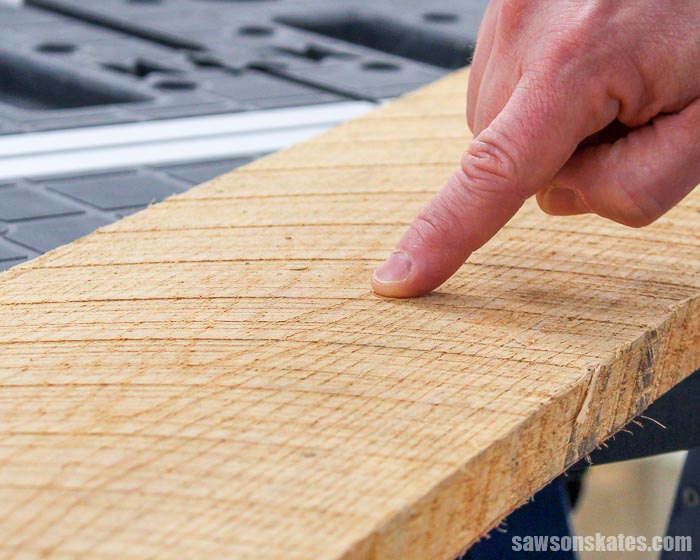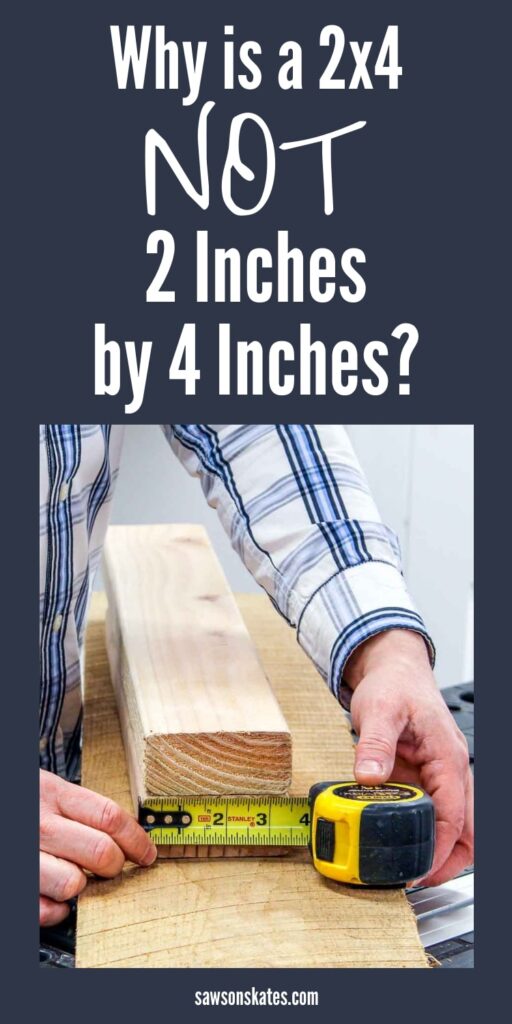Beginner’s Guide to Wood Sizes
Wood sizes are confusing! Why is a 2×4 not 2 inches by 4 inches? I’m sharing why actual wood sizes are different so you can understand how and what to buy.

Nominal vs Actual Wood Sizes
Woodworking can sometimes be confusing. Especially for beginner woodworkers. There are so many numbers and terms to learn. I understand that it’s easy to become overwhelmed. Today we’ll learn why a 2×4 is not 2 inches by 4 inches and I’ll share helpful tips about understanding wood sizes.
Related: Beginner’s Guide to Woodworking Terms
This post contains affiliate links to supplies or tools I used to complete this project. Purchases made using these links help support the Saws on Skates website and allow me to share more DIY projects. and DIY tips with you. There is no cost to you for using these links. Click here to visit my site policies.
Before we get into understanding wood sizes, be sure to click the subscribe button at the bottom of this page to sign up for my FREE weekly newsletter loaded with helpful pocket hole tricks, space-saving workshop ideas, clever DIY tips and more!
Table of Contents
- What Do the Numbers Mean in Wood Sizes?
- What is Nominal Lumber?
- What is Dimensional Lumber?
- Why Are Lumber Nominal and Actual Sizes Different?
- Softwood vs Hardwood
- Softwood Lumber Sizes
- Hardwood Lumber Sizes
- Plywood Thicknesses
What Do the Numbers Mean in Wood Sizes?
We’ll often see woodworking plans calling for a board like a 2x4x8 (spoken as a two by four by eight or just two by four).
Let’s look a little closer at a 2×4×8 and breakdown what each number means. The first number (2) refers to the thickness of the board in inches. The second number (4) refers to the width of the board in inches. The third number (8) refers to the length of the board in feet.
So that’s the first confusing thing about understanding wood sizes. The thickness and width of a board are measured in inches and the length is measured in feet
But there’s more. If we measure a 2×4×8 we’ll see that it actually measures 1-½ inches × 3-½ inches × 8 feet. That’s confusing. Why is a 2×4 not 2 inches by 4 inches? For that answer, we’ll need to look at the difference between nominal lumber and dimensional lumber.
What is Nominal Lumber?
Nominal lumber is unfinished boards. The measurements of nominal lumber is the size of the board before it has been planed smooth to its final dimensions.
After a tree is cut, the log is milled or rough sawn to thickness and width. The surface of nominal lumber has saw marks, and it feels rough to the touch.

In the past, a nominal 2×4 would be rough cut to about 2 inches by 4 inches. Next, the lumber was allowed to air dry. Wood becomes smaller as it dries. It shrinks the most across its width.
When the wood was dry, a planer was used to smooth the board on all four sides. A planer has a rotating cutter head. The cutter head spins and removes a portion of the wood. This removes the saw marks and smooths the board.
Between the drying and planing process, a 2×4 board ended up with a final size of 1-½ inches by 3-½ inches.
Modern technology and kiln drying (rather than air drying) have allowed modern nominal lumber to be cut smaller than 2 inches by 4 inches but the final size of the board is still 1-½ inches by 3-½ inches. The same goes for other size boards too. The actual size of boards like 1x3s, 1x4s, 1x6s, etc., is smaller than their nominal dimensions.
Nominal lumber or rough sawn wood is available from sawmills. We can mill rough sawn lumber to its final size with a planer and jointer. Or more commonly, DIYers will buy dimensional lumber that has already been finished to a standard size.
Related: Jointer vs Planer: Differences & Which to Buy First
What is Dimensional Lumber?
Dimensional lumber is wood that has been planed. The saw marks have been removed and the board is smooth. Dimensional lumber is cut to standard thicknesses and widths.
Dimensional lumber is the actual size of the board but the nominal dimension is the size we see printed or labeled on the wood. In other words, we’re buying a nominal size 2×4 board but the dimensional or actual size is 1-½ inches by 3-½ inches.
Dimensional lumber is the wood we commonly buy for our DIY projects at big box home improvement stores.
Why Are Nominal vs Actual Sizes Different?
Now we have a better understanding of the difference between nominal lumber and dimensional lumber.
Nominal lumber is unfinished boards. A nominal 2×4 is rough sawn to about 2 inches by 4 inches.
Dimensional lumber is finished boards. A nominal size 2×4 board has been planed to its finished size of 1-½ inches by 3-½ inches. The finished boards are the actual size of the wood we use to build our DIY projects.
The nominal size is the standard for labeling dimensional lumber not the actual size of the finished board.
Softwood vs Hardwood
Wood sizes are even more confusing when we compare softwoods and hardwoods.
What are Softwoods?
American Hardwoods™ defines softwoods as “cone-bearing” trees that have needles rather than leaves. Softwoods we may commonly work with are pine and cedar.
Softwoods are soft. They are easily dented. Many softwoods will actually dent if we push our fingernails into it.
What are Hardwoods?
American Hardwoods™ defines hardwoods as “deciduous trees that have broad leaves, produce a fruit or nut and generally go dormant in the winter.” Hardwoods we may normally work with are oak, maple, and poplar.
As we might expect, hardwoods are much harder than softwoods. They are not easily dented. It would be difficult to make a dent on the surface if we tried to push our fingernails into a hardwood.
Softwood Lumber Sizes
Softwoods are sold in dimensional or standard sizes but are labeled with nominal dimensions like 1×4 or 2×4. They are typically sold by the piece or by the linear foot.
Here are some common dimensional boards that we’ll often see in woodworking plans.
1x Wood Sizes
| NOMINAL SIZE (INCHES) | ACTUAL SIZE (INCHES) | ACTUAL SIZE (METRIC) |
| 1×2 | 3/4″ × 1-1/2″ | 19 × 38 mm |
| 1×3 | 3/4″ × 2-1/2″ | 19 × 64 mm |
| 1×4 | 3/4″ × 3-1/2″ | 19 × 89 mm |
| 1×5 | 3/4″ × 4-1/2″ | 19 × 114 mm |
| 1×6 | 3/4″ × 5-1/2″ | 19 × 140 mm |
| 1×8 | 3/4″ × 7-1/4″ | 19 × 184 mm |
| 1×10 | 3/4″ × 9-1/4″ | 19 × 235 mm |
| 1×12 | 3/4″ × 11-1/4″ | 19 × 286 mm |
2x Wood Sizes
| NOMINAL SIZE (INCHES) | ACTUAL SIZE (INCHES) | ACTUAL SIZE (METRIC) |
| 2×2 | 1-1/2″ × 1-1/2″ | 38 × 38 mm |
| 2×3 | 1-1/2″ × 2-1/2″ | 38 × 64 mm |
| 2×4 | 1-1/2″ × 3-1/2″ | 38 × 89 mm |
| 2×6 | 1-1/2″ × 5-1/2″ | 38 × 140 mm |
| 2×8 | 1-1/2″ × 7-1/4″ | 38 × 184 mm |
| 2×10 | 1-1/2″ × 9-1/4″ | 38 × 235 mm |
| 2×12 | 1-1/2″ × 11-1/4″ | 38 × 286 mm |
Hardwood Lumber Sizes
Hardwoods are sold differently than softwoods. Hardwood sizes are based on how many sides have been planed or surfaced. Hardwood boards may be surfaced on one side (S1S) or on two sides (S2S).
Hardwoods are typically sold by the board foot rather than by the piece or by the linear foot like softwoods. Board feet is a measurement based on volume.
One board foot equals 144 cubic inches of wood. A board that is 1 inch thick, 12 inches wide and 12 inches long (1 × 12 × 12) equals 144 cubic inches or 1 board foot.
Hardwoods are also typically sold by the quarter. Each quarter is equal to a ¼ inch of thickness. In other words, a 4/4 board (spoken as four-quarter) is about 1 inch thick. A 4/4 board that has been surfaced on one side (S1S) will measure about 7/8″ thick. A 4/4 board that has been surfaced on two sides (S2S) will measure about 13/16″ inches thick.
Hardwoods are usually sold in random widths, but they can also be sold in standard widths like softwoods. My local lumberyard sells common hardwoods like oak, maple, and mahogany in dimensional widths like softwoods, but they sell exotic hardwoods in random widths.
| QUARTER SIZE (INCHES) | NOMINAL SIZE (INCHES) | ACTUAL SIZE S1S | ACTUAL SIZE S2S |
| — | 1/2″ | 3/8″ (10 mm) | 5/16″ (8 mm) |
| — | 5/8″ | 1/2″ (13 mm) | 7/16″ (11 mm) |
| — | 3/4″ | 5/8″ (16 mm) | 9/16″ (14 mm) |
| 4/4 | 1″ | 7/8″ (22 mm) | 13/16″ (21 mm) |
| 5/4 | 1-1/4″ | 1-1/8″ (29 mm) | 1-1/16″ (27 mm) |
| 6/4 | 1-1/2″ | 1-3/8″ (35 mm) | 1-5/16″ (33 mm) |
| 8/4 | 2″ | 1-13/16″ (46 mm) | 1-3/4″ (44 mm) |
| 12/4 | 3″ | 2-13/16″ (71 mm) | 2-3/4″(70 mm) |
| 16/4 | 4″ | 3-13/16″ (97 mm) | 3-3/4″ (95 mm) |
Plywood Thicknesses
The common size for plywood sheets is 4 feet x 8 feet and 2 feet by 4 feet but other sizes are available. Most plywood also has a nominal thickness and an actual thickness. The common nominal thickness of plywood is ⅛ inch, ¼ inch, ½ inch, and ¾ inch.
Sanding or smoothing the plywood sheet during the manufacturing process can remove about a 1/32 inch of material. This means a ¼ inch thick piece of plywood will actually measure about 7/32 inch thick.
Final Thoughts
Wood sizes can be confusing. Today we learned why nominal and actual wood sizes are different and why 2×4 is not 2 inches by 4 inches. Nominal lumber is unfinished boards. Dimensional lumber is finished boards. The nominal measurements is the standard for measuring dimensional lumber.
Thank you for stopping by. If you found this information helpful, would you please pin it to Pinterest? Other DIYers would appreciate it and I would too! Thank you – Scott


This is very clear cut (no pun intended), and informative! I started a job at a home improvement store, and feel very out of my depth in regards to lumber.
This article was super helpful, and I appreciate you for writing it. 🙂
Thank You for all you do to help us!!.. This tutorial on board dimensions would have been great several months ago for me!!.. Miscalculated coverage of wider boards because of being 1/4” vs 1/2”!!…